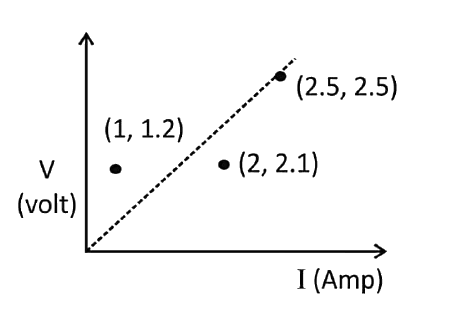What is the relation between V and I from Ohm's law.
V depends on I linearly
V doesn't depend on I
V depend on I non-linearly
Can't say
The correct Answer is:C
To derive the relationship between voltage (V) and current (I) as stated in Ohm's Law, we can follow these steps:
Step 1: Understanding Ohm's Law
Ohm's Law states that the current (I) flowing through a conductor between two points is directly proportional to the voltage (V) across the two points. This can be mathematically expressed as:
V=I×R
where R is the resistance of the conductor.
Step 2: Rearranging the Equation
From the equation V=I×R, we can see that if we know the resistance (R), we can express the relationship between voltage and current. Rearranging gives:
I=VR
This shows that current is directly proportional to voltage when resistance is constant.
Step 3: Graphical Representation
If we plot a graph of voltage (V) on the y-axis and current (I) on the x-axis, the relationship is linear. The slope of the line is equal to the resistance (R):
- If R is constant, the graph will be a straight line passing through the origin.
- The slope of the line (θ) represents the resistance:
R=VI
Step 4: Conclusion
Thus, the relationship between voltage (V) and current (I) according to Ohm's Law is that they are directly proportional to each other when resistance is constant. This means that if the voltage increases, the current will also increase, provided the resistance does not change.
Summary
The relationship between V and I from Ohm's law is:
V∝I
This indicates a linear relationship where the slope of the line is the resistance (R).
---
Ohm's Law states that the current (I) flowing through a conductor between two points is directly proportional to the voltage (V) across the two points. This can be mathematically expressed as:
V=I×R
where R is the resistance of the conductor.
From the equation V=I×R, we can see that if we know the resistance (R), we can express the relationship between voltage and current. Rearranging gives:
I=VR
This shows that current is directly proportional to voltage when resistance is constant.
If we plot a graph of voltage (V) on the y-axis and current (I) on the x-axis, the relationship is linear. The slope of the line is equal to the resistance (R):
- If R is constant, the graph will be a straight line passing through the origin.
- The slope of the line (θ) represents the resistance:
R=VI
Thus, the relationship between voltage (V) and current (I) according to Ohm's Law is that they are directly proportional to each other when resistance is constant. This means that if the voltage increases, the current will also increase, provided the resistance does not change.
The relationship between V and I from Ohm's law is:
V∝I
This indicates a linear relationship where the slope of the line is the resistance (R).
Topper's Solved these Questions
- BOOK - EDUCART PUBLICATIONCHAPTER - SAMPLE PAPER 5EXERCISE - SECTION - B24videos
SAMPLE PAPER 5
- BOOK - EDUCART PUBLICATIONCHAPTER - SAMPLE PAPER 5EXERCISE - SECTION - C6videos
SAMPLE PAPER 5
- BOOK - EDUCART PUBLICATIONCHAPTER - SAMPLE PAPER 3EXERCISE - SECNTION -C6videos
SAMPLE PAPER 3
- BOOK - EDUCART PUBLICATIONCHAPTER - SAMPLE PAPER 6EXERCISE - Section-C6videos
SAMPLE PAPER 6
Similar Questions
Knowledge Check
- Question 1 - Select One
Ohm's law is .
AV=RlBl=V×RCR=V2×lDV = l R - Question 2 - Select One

In the measurement of resistance of a wire using Ohm's, the plot between V and I is drawn as shown. The resistance of the wire is-A0.833ΩB0.9ΩC1ΩDNone of these - Question 3 - Select One
Ohm's law defines
Aresistance onlyBcurrent onlyCvoltage onlyDboth current and voltage
Use your brain power!
M=h2h1 …..(i)
M=vu …..(ii)
From equations (i) and (ii) what is the relation between h1,h2,uandv ?View SolutionExplain the Ohm's law.
View SolutionApplying first law of thermodynamics, obtain an adiabatic relation between pressure and volume. Hence write relation between P and T and also between V and T.
View SolutionIn the measurement of resistance of a wire using Ohm's the plot between V and I is drawn as shown, then resistance of given wire will be
 View Solution
View SolutionOhm's law defines
View Solution

